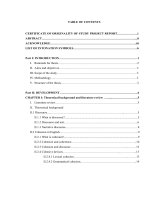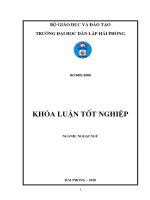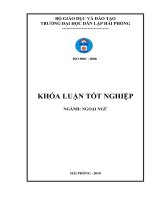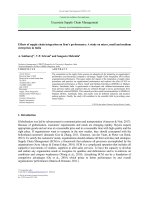A STUDY ON BLOCKCHAIN SYSTEM AND CRYPTOCURRENCY USE IN INDIAN FINANCIAL SYSTEM
Bạn đang xem bản rút gọn của tài liệu. Xem và tải ngay bản đầy đủ của tài liệu tại đây (620.18 KB, 43 trang )
<span class="text_page_counter">Trang 1</span><div class="page_container" data-page="1">
Project Report
<b>“A STUDY ON BLOCKCHAIN SYSTEM AND CRYPTOCURRENCY USE IN INDIAN FINANCIAL </b>
<b>SYSTEM” </b>
Submitted to
<b> Rashtrasant Tukadoji Maharaj University , Nagpur </b>
In partial fulfilment for the award of the degree of
<b>Bachelor of Business Administration </b>
Submitted by
<b>ADITYA N. SINGH </b>
Under the guidance of
<b> Dr. AFSAR SHEIKH </b>
<b><small>G.S. College of Commerce & Economics, Nagpur NAAC Re-Accredited “A” Grade Autonomous Institution </small></b>
<b><small>Academic Year 2020-21 </small></b>
</div><span class="text_page_counter">Trang 2</span><div class="page_container" data-page="2"><b><small>G.S. College of Commerce & Economics, Nagpur Academic year 2020-21 </small></b>
<b><small>DECLARATION </small></b>
<small>I here-</small><b><small>by declare that the project with title “ A study on blockchain system </small></b>
<b><small>andcryptocurrency use in Indian Financial System” has been completed by me in partial fulfilment of BACHELOR OF BUSINESS </small></b>
<b><small>ADMINISTRATION degree examination as prescribed by Rashtrasant </small></b>
<b><small>Tukadoji Maharaj Nagpur University, Nagpur and this has not been submitted for any other examination and does not form the part of any other course undertaken by me. </small></b>
<b><small>ADITYA N. SINGH </small></b>
<b><small> </small></b>
<b><small>PLACE: NAGPUR DATE: </small></b>
</div><span class="text_page_counter">Trang 3</span><div class="page_container" data-page="3"><b><small>G.S. College of Commerce & Economics, Nagpur Academic year 2020-21 </small></b>
<b><small>AKNOWLEDGEMENT </small></b>
<small>With immense pride and sense of gratitude, I take this golden opportunity to express my sincere regards to Dr. N. Y. Khandait, Principal, G.S College of Commerce & Economics , Nagpur. I am extremely thankful to my project guide Dr. Afsar Sheikh for her guideline throughout the project. I tender my sincere regards to co-ordinator, Dr. Geeta. Naidu for giving me outstanding guidance, enthusiastic suggestions and invaluable encouragement which helped me in the completion of the project. I will fail in my duty if I do not thank the non-teaching staff of the college for their cooperation. I would like to thanks all those who helped me in making this project complete and successful. </small>
<b><small>ADITYA N. SINGH </small></b>
<b><small>PLACE: NAGPUR DATE: </small></b>
</div><span class="text_page_counter">Trang 4</span><div class="page_container" data-page="4"><b><small>G.S. College of Commerce & Economics, Nagpur Academic year 2020-21 </small></b>
<b><small>CERTIFICATE </small></b>
<b><small>This is to certify that “Aditya N.Singh” has submitted the project report titled “A study on blockchain system andcryptocurrency use in Indian Financial System” towards partial fulfilment of BACHLOR OF BUSINESS </small></b>
<b><small>ADMINISTRATION degree examination. This has not been submitted for </small></b>
<small>any other examination and does not form part of any other course undergone by the candidate. It is further certified that he has ingeniously completed his project as prescribed by Rashtrasant Tukadoji Maharaja University, Nagpur. </small>
<b><small>Dr. Afsar Sheikh Dr. Geeta V. Naidu </small></b>
<b><small>(Project guide ) (Co-ordinator) </small></b>
<b><small> PLACE: NAGPUR DATE: </small></b>
</div><span class="text_page_counter">Trang 5</span><div class="page_container" data-page="5"><b><small>G.S. College of Commerce & Economics, Nagpur </small></b>
<b><small>7 Bibliography & References 42 </small></b>
</div><span class="text_page_counter">Trang 6</span><div class="page_container" data-page="6"><b>INTRODUCTION </b>
</div><span class="text_page_counter">Trang 7</span><div class="page_container" data-page="7"><b>Introduction </b>
A cryptocurrency is a digital or virtual currency that is secured by cryptography, which makes it nearly impossible to counterfeit or double-spend. Many cryptocurrencies are decentralized networks based on blockchain technology a distributed ledger enforced by a disparate network of computers. A defining feature of cryptocurrencies is that they are generally not issued by any central authority, rendering them theoretically immune to government interference or manipulation. Cryptocurrencies are systems that allow for secure payments online which are denominated in terms of virtual "tokens," which are represented by ledger entries internal to the system. "Crypto" refers to the various encryption algorithms and cryptographic techniques that safeguard these entries, such as elliptical curve encryption, public-private key pairs, and hashing functions
<b>BEGINNING </b>
The first blockchain-based cryptocurrency was Bitcoin, which still remains the most popular and most valuable. Today, there are thousands of alternate cryptocurrencies with various functions and specifications. Some of these are clones or forks of Bitcoin, while others are new currencies
<b>that were built from scratch. </b>
Bitcoin was launched in 2009 by an individual or group known by the pseudonym "Satoshi Nakamoto." As of March 2021, there were over 18.6 million bitcoins in circulation with a total market cap of around $927 billion. Some of the
</div><span class="text_page_counter">Trang 8</span><div class="page_container" data-page="8">competing cryptocurrencies spawned by Bitcoin’s success, known as "altcoins," include Litecoin, Peercoin, and Namecoin, as well as Ethereum, Cardano, and EOS. Today, the aggregate value of all the cryptocurrencies in existence is around $1.5 trillion Bitcoin currently represents more than
<b>60% of the total value. </b>
Central to the appeal and functionality of Bitcoin and other cryptocurrencies is blockchain technology, which is used to keep an online ledger of all the transactions that have ever been conducted, thus providing a data structure for this ledger that is quite secure and is shared and agreed upon by the entire network of an individual node, or computer maintaining a copy of the ledger. Every new block generated must be verified by each node before being confirmed, making it almost impossible to forge transaction histories.
Many experts see blockchain technology as having serious potential for uses like online voting and crowdfunding, and major financial institutions such as JPMorgan Chase (JPM) see the potential to lower transaction costs by streamlining payment processing. However, because cryptocurrencies are virtual and are not stored on a central database, a digital cryptocurrency balance can be wiped out by the loss or destruction of a hard drive if a backup copy of the private key does not exist. At the same time, there is no central authority, government, or corporation that has access to
<b>your funds or your personal information. </b>
</div><span class="text_page_counter">Trang 9</span><div class="page_container" data-page="9"><b>LITERATURE REVIEW </b>
</div><span class="text_page_counter">Trang 10</span><div class="page_container" data-page="10"><b>Literature Review</b>
A literature review goes beyond the search for information and includes the identification and articulation of relationship between the literature and your field of research. While the form of the literature review may vary with different types of studies, the basic purposes remain
<b>constant: </b>
<b>• Provide a context for the research • Justify the research. </b>
• Ensure the research has not been done before ( or
<b>that it is not just a “replication study”) </b>
• Show where the research fits into the existing body
<b>of knowledge. </b>
• Illustrate the researcher to learn from previous theory
<b>on the subject. </b>
<b>• Highlight flaws in previous research. • Outline gaps in previous research. </b>
• Show that the work is adding to the understanding
<b>and knowledge of the field. </b>
<b>• Help refine, refocus or even change the topic. </b>
This section of the research study shall look at the finding by other researchers on cryptocurrency and other related areas of study from different countries and places. This chapter provides a detailed literature review in trying to provide solutions of the research questions identified in the research paper. This involves a review of literature relating to cryptocurrencies and blockchain. This chapter shall also look into various
</div><span class="text_page_counter">Trang 11</span><div class="page_container" data-page="11">theories and findings by other authors on bitcoins being able to solve liquidity crunch faced by various nations and factors that influence the adoption of bitcoin by
<b>banks </b>
Cryptocurrencies According to Trautman (2014), cryptocurrencies are a subset of digital currencies, which may either have centralized institutions or are based on a decentralized network (Trautman 2014). Bryans (2014) is of the idea that, for a centralized currency scheme, the digital currency is issued by one institution, which ensures that the digital coins can be exchanged back to fiat currencies or can be used to buy and sell digital goods. One example for this centralized digital currency is the Linden Dollar, issued by Linden Lab, which can be used in the online virtual world Second Life. It shares some characteristics with fiat currencies. Like in the traditional money system, a central institution serves as a source of trust. However according to Karlstrom (2014), decentralized currency schemes try to avoid central institutions as much as possible and are built on a network of transaction partners As long as the transaction partners can observe each other, they can build up trust based on their behaviours. If observation of the transaction partners is not possible, other mechanisms have to be found to establish reliable transactions. One solution lies in cryptocurrencies, which are decentralized currency schemes based on cryptography. According to Bryans (2014) a cryptocurrency is a digital token produced by cryptographic algorithms. This token is then transported across cyberspace using protocols
</div><span class="text_page_counter">Trang 12</span><div class="page_container" data-page="12">such as peer-to-peer networking. Its value is mainly
<b>derived from the demand and supply for such tokens. </b>
The focus on cryptocurrencies in the finance and banking sectors is gaining momentum. In this paper, we investigate the role of cryptocurrencies in modern finance. We apply a narrative literature review method to synthesize prior research and draw insights into the opportunities and challenges of leveraging cryptocurrencies. The results indicate that cryptocurrencies offer businesses and individuals lower transaction costs, higher efficiencies, increased security and privacy, meaningful diversification benefits, alternative financing solutions, and financial inclusion. Challenges exist related to the integration of cryptocurrencies in modern finance. These include the lack of regulatory standards, the risk of criminal activity, high energy and environmental costs, regulatory bans and usage restrictions, security and privacy concerns, and the high volatility of cryptocurrencies. The current review is useful for scholars and managers, including those seeking to have a more balanced understanding
<b>of these emerging financial instruments. </b>
</div><span class="text_page_counter">Trang 13</span><div class="page_container" data-page="13"><b>RESEARCH METHODOLOGY </b>
</div><span class="text_page_counter">Trang 14</span><div class="page_container" data-page="14"><b>Research Methodology </b>
Research methodology is a collective term for the structured process of conducting research. There are many different methodologies used in various types of research and the term is usually considered to include research design, data gathering and data analysis. Research methodologies can be quantitative (for example, measuring the number of times someone does something under certain condition) or qualitative (for example, asking people how they feel about a certain situation). Ideally, comprehensive research should try to incorporate both qualitative and quantitative methodologies but this is not always possible, usually due to time and financial constraints.
Research methodologies are generally used in academic research to test hypotheses or theories. A good design should ensure the research is valid, i.e. it clearly tested the hypothesis and not extraneous variables, and that the research is reliable, i.e.it yields consistent results every time. Part of the research methodology is concerned with the how the research is conducted. This is called the study design and typically involves research conducted using questionnaires, interviews, observation and or experiments. The term research methodology, also referred to as research methods, usually encompasses the procedures followed to analyse and interpret the data gathered. These often use a range of sophisticated statistical analyses of the data to identify correlation or statistical significance in the results.
</div><span class="text_page_counter">Trang 15</span><div class="page_container" data-page="15">Objective, representative research can be difficult to conduct because tests can normally only be conducted on a small sample (e.g. you cannot test a drug on every person in the world so a sample needs to be used in research). This means that researchers need to have a very detailed understanding of the types and limitations of research methodologies which they are using.
</div><span class="text_page_counter">Trang 16</span><div class="page_container" data-page="16"><b>NEED OF STUDY </b>
</div><span class="text_page_counter">Trang 17</span><div class="page_container" data-page="17"><b>Need of Study </b>
The study is to forecast the future of Indian Financial System the recent changes seen in the international monetary transactions and the emerging concept called Blockchain and cryptocurrency. This study might help us understand and analyze what all aspects we need to go through and upgrade if we are really adopting the futuristic technology like Japan and Australia.
It also focuses on the basic infrastructural changes we need to adopt like strong Information Technology framework, Cyber security, Cryptoliteracy,channel of work and its reach towards the remote villages of our country. Various MNCs like Tesla, Facebook, Amazon are already creating infrastructure and accepting bitcoin for financial settlements. Various companies like JP Morgan Chase, Bank of America, Morgan Stanley are already working on creating easy and efficient blockchain mechanism which is easy for users and difficult for hackers to capture.
India's Supreme court has already lifted the ban on Bitcoin which was imposed by the RBI. The Indian Financial regulator RBI is also looking towards launching its own cryptocurrency called Lakshmi. India's literacy level, Per capita Income and integrity with electricity and internet creates a question for cryptocurrency that we need to address in this project report. The need of study also becomes more important to prepare yourself for the new financial education, career perspectives and its scope for emerging businesses. The chartered Accountant might be replaced by the Miners of Virtual currency.
</div><span class="text_page_counter">Trang 18</span><div class="page_container" data-page="18"><b>OBJECTIVE OF STUDY </b>
</div><span class="text_page_counter">Trang 19</span><div class="page_container" data-page="19"><b>Objective of Study </b>
• To study the level of awareness towards Cryptocurrency and Blockchain system
• To analyze the perception of government, Private Institutions, Society
• To determine Investor’s views towards Cryptocurrency as an investment class asset.
• To determine the current investment patterns in cryptocurrency which is still not legal.
• To determine influential factors when investing or using it as a medium of exchange.
• To determine the changes we need to adopt if we are using blockchain and cryptocurrency.
• To understand the global position of Cryptocurrency and blockchain and understand whether it can replace US Dollars as international currency of exchange.
</div><span class="text_page_counter">Trang 20</span><div class="page_container" data-page="20"><b>RESEARCH DESIGN </b>
</div><span class="text_page_counter">Trang 21</span><div class="page_container" data-page="21"><b>Research Design </b>
Data were collected through both primary & secondary data sources. Primary data was collected through questionnaires. The research was done in the form of direct personal interviews and through telephone interviews.
<b>Primary data collection: </b>
A primary data is a data, which is collected afresh and for the first time, and thus happen to the original in character. The primary data with the help of questionnaire were
collected from various investors? Primary data are first-hand information and are collected from various source like:
❖Informal interviews
❖Through structured questionnaire ❖Observation
<b>Secondary Data Collection: </b>
The Secondary source consist of readily available data and is already compiled statistical statement and reports. Secondary data are collected from:
</div>








